|
Текущее время: 01 ноя 2024, 02:36 |
|
Часовой пояс: UTC + 3 часа |
|
|
Страница 1 из 1 |
[ Сообщений: 9 ] |
| Версия для печати | Пред. тема | Первое новое сообщение | След. тема |
"Wheel Alignment" с ниточкой и резиночкой
| Автор | Сообщение |
|---|---|
|
Зарегистрирован: 14 авг 2014, 11:35 Сообщения: 3238 Откуда: Королев, Владимир Мотоцикл(ы): FLHTC1991; HondaSlasher400 |
Нарыл в сети метод регулировки положения двигателя-трансмиссии-заднего колеса в раме. По форуму не нашел, на наводящие вопросы мне тоже никто, по этому именно способу, не ответил.
Собственно способ: Цитата: Harley Davidson Wheel Alignment Made Simple In an ideal world the front and rear wheel should be: 1. Inline 2. Not offset from each other 3. In the same plane, i.e. if the front wheel is vertical, the back wheel is also perfectly vertical. In practice: 1. We can adjust 2. Hardly ever true, the rear wheel is usually offset 5 to 15mm but we can live with it 3. We could have a problem, possibly a bent frame, but we can check it. Wheels that are not in alignment can cause handling problems, excessive tire wear and damage the drive belt/chain and pulleys. The H-D manual suggests that wheel alignment should be done using straightedges.  The usually prescribed method is to support the bike, lay straight edges along the rear wheel, and measure the gaps at the front. See figure 1. To make things more difficult, the rear wheel can be offset up to 15mm relative to the front (depending on model). So, the method is. 1. Support the bike 2. Hold a couple of 2 meter long straight edges against the rear wheel 3. Turn the bars as near parallel as possible to the straight edges 4. Measure the gaps A,B, C & D 5. If A = C and B = D, then you've done it, if not, adjust rear wheel and try again. Not too easy, even supposing you've got 2-metre long straight edges, and 3 meter long arms. In practice you need at least 2 people and the method is really prone to error, 1 degree out in holding the straightedge will give you an error of over an inch.. The Easy, Accurate Way: Materials Needed: 1. Fishing line, about 5 or 6 meters (or strong thread) 2. A nut or similar to use as a weight 3. A piece of strong wire bent into an 'S' shape making a hook about 2” long (coat hanger wire is perfect) 4. A long rubber band (about 6” is ideal) or 2 shorter joined together 1) Check the Tires: Check that tire pressures are correct, Ensure that the tires are fitted true to the rime. Usually there is a line around the tire wall. This must be concentric to the wheel rim. 2) Prop the Bike Vertically Use a lift: if you've got one, otherwise maneuver onto blocks. Check for vertical alignment using a piece of fishing line with the nut tied on the end to act as a plumb line. See figure 2. Shim the blocks or lift until the line just touches the tire at the top and bottom edges of the tire. If you've got patient, strong friends they can brace themselves and hold the bike steady instead of using blocks. Don't worry if it's not exactly vertical, ‘nearly’ is good enough.  3) Attach the fishing line: Attach one end off the remaining fishing line to your hook. String your line around the back wheel, down the side, around the front tire and down the other side. Trim to length, tie to rubber band and clip the hook attached to the first end to the rubber band. See figures 3a, 3b. 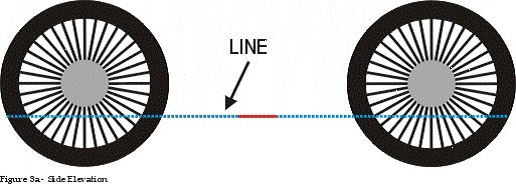  Ideally, the line should be as far up the wheels as possible. Make sure that the line touches only the tires! If it catches on foot pegs or exhaust, you will need to move it up and down until it just touches the tires. For simplicity, all the illustrations show that the rear wheel without offset relative to the front. In practice it will be, but the amount is usually small enough to make no difference to this alignment procedure. If you want to be sure, read the last section which deals with large rear wheel offsets. 4) Test the Alignment: Slowly turn the bars clockwise. Keep checking the line. Hopefully, you should be able to get the line to touch  Touch the tires at al four points A,B,C and D (see figure 4). Check by inserting a thin piece of paper at points B & C (don’t worry if either B or C don’t touch, but if A or D don't, then boy do you have a problem), a cigarette paper is ideal. If the line is touching, the paper should be held in place by tension only.  Repeat, this time turning the bars anti-clockwise. If you're really lucky, the line will touch the tires at E,F,G,H (see figure 5). If this is the case, then your wheels are aligned.  Now look at figure 6. (Above) This shows an example of the rear wheel misaligned towards the left. If you move the bars to the right, you can still get the line to touch at 4 points (fig 7a). But see what happens when we turn the bars to the left (fig 7b).  5) Adjust the Alignment: We have seen above how a rear wheel skewed to the left will not allow the string to touch the right rear tire (point ‘G’ in figure 5). The converse is also true; a skew to the right and you will not be able to touch the left rear tire (point ‘C’ in figure 4). So to correct our left skew above, remove the split pin, loosen the axle nut and slacken off the adjuster on the right side. Tap the type until it settles against the adjusters. Tighten the axle nut and repeat from section 4 until in line. You will note that I specified adjusting the wheel by slackening the relevant adjuster. You may be tempted to tighten the adjuster on the other side of the wheel which will have the same effect, won’t it? Don’t do it! It will move the wheel alignment but it will also apply more tension to the drive belt or chain, possibly causing damage! 6) Check your belt/Chain tension After you’ve got everything nicely lined up, turn the rear wheel and feel the belt/chain tension as it moves round. Leave the wheel in the position where the tension is highest. Sit someone on the bike (you may need to remove the lift or blocks for safety). The belt should move about 10 - 13mm if you put about 4.5Kg of pressure on it (Chains should have about 25mm of movement). You may need to remove the belt guard to judge this. If the belt/chain is slack, and it probably will be, loosen the axle nut and turn each adjuster the same amount until you get the tension right. Tighten axle nut (60ft lb torque) and recheck tension. If correct, then you need to check your wheel alignment again just to make sure it hasn’t moved. 7) Reinstall Split Pin removed in step 5: That’s it, all aligned. Although it might be a good idea to check that you tightened everything properly before you go out on it. Appendix *A Note on Wheel Offset: Modern Harley-Davidsons have the rear wheel offset somewhere between 8 and 13mm. (See fig 8)  Throughout this document, I have assumed in this document that the offset is less than half the difference in width between the rear and front tires (it usually is). Z < (r-f)/2 Where: Z = offset r = width of rear tire f = width of front tire If your wheel offset falls outside these parameters, e.g. custom frames with large offsets, then you will need to modify the procedure. The easiest way to do this is shown in figure 9.  The batons on the side of the tire effectively increase the tire width Special Thanks To Wide! Motorcyclemetal.com Inc. 5490 S.W. 42nd St. Davie, FL 33314 1-866-899-5962 Toll free 1-954-449-6173 Local Суть по русски: вокруг колес натягивается нитка, по зазору между покрышкой и этой ниткой судят о положении power-train. Оригинал: http://www.google.ru/url?sa=t&rct=j&q=&esrc=s&source=web&cd=1&cad=rja&uact=8&ved=0ahUKEwi20NeJmqbUAhWD6CwKHcibAPUQFggkMAA&url=http%3A%2F%2Fwww.motorcyclemetal.com%2Fdownloads%2Fharley%2520Davidson%2520Wheel%2520Alignment%2520Made%2520Simple.pdf&usg=AFQjCNHQ51P4HIXBtIH3Wem5dz4FFVjy8Q&sig2=ArkqQYuXEtk3W4tAC9oVVg |
| 05 июн 2017, 11:04 |
|
|
Зарегистрирован: 14 авг 2014, 11:35 Сообщения: 3238 Откуда: Королев, Владимир Мотоцикл(ы): FLHTC1991; HondaSlasher400 |
В выходные попробовал им воспользоваться. Как получилось пока не понятно, мотоцикл у меня из разряда недвижимости пока
В отличии от описания у меня колеса одинаковые вроде. По этому после натяжения нитки она по идее должна во всех местах прикасаться к баллонам. Все достаточно просто получается. 2-х рук вполне хватает. Единственное, что пришлось зафиксировать переднее колесо скотчем, а то крутится. 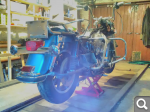 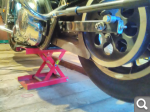 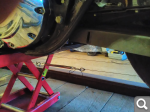 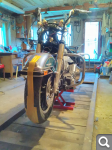 Ну и с выравниванием заднего колеса по вертикали тоже вопросы. Мотоцикл висит не строго вертикально, руки с отвесом дрожат, глаза косят. Правда в рекомендации написано "примерно, тоже пойдет" Вопрос простой, кто кроме меня пробовал, как впечатления и результаты? Как в сравнении с обычной линейкой? |
| 05 июн 2017, 11:08 |
|
|
Зарегистрирован: 27 сен 2016, 09:34 Сообщения: 1401 Откуда: Латв.ССР Мотоцикл(ы): k750 FXDWG 1998 |
grub писал(а): Мотоцикл висит не строго вертикально, руки с отвесом дрожат, глаза косят. можно снять сиденье, и уровень на раму положить, всяко точнее будет. способ интересный, зимой буду менять подушки, крутить-вертеть "косточки", и проверять колейность. с "линейками" чёта у меня не очень удобно получалось. правда ,линейки стальные были, из полосы 50х8. не очень удобно. |
| 28 июл 2021, 07:34 |
|
|
Зарегистрирован: 11 май 2015, 16:27 Сообщения: 999 Откуда: Рига - Мюнхен Мотоцикл(ы): fltc'91 |
Делал и горизонт и вертикаль. Горизонт вообще просто: выставил ось заднего колеса относительно оси маятника, с помощью специнструмента - загнутой проволочки, потом резинки на колеса или правИло строительное и крути переднюю тягу. С правИлом нужны вторые руки.
Вертикаль сложнее, потому, как весь мопед надо вывесить на чём то.. на домкратах например и уровнем, а лучше двумя, а лучше лазерным выставлять его в горизонт. Ну и выравнивать оси лазером, или раму по уровню.. Короче, крайне занятный процесс. |
| 29 июл 2021, 10:23 |
|
|
Зарегистрирован: 02 мар 2020, 06:30 Сообщения: 100 Откуда: Казань Мотоцикл(ы): FLTRX 2010 был(( |
scobak писал(а): Делал и горизонт и вертикаль. Горизонт вообще просто: выставил ось заднего колеса относительно оси маятника, с помощью специнструмента - загнутой проволочки, потом резинки на колеса или правИло строительное и крути переднюю тягу. С правИлом нужны вторые руки. Вертикаль сложнее, потому, как весь мопед надо вывесить на чём то.. на домкратах например и уровнем, а лучше двумя, а лучше лазерным выставлять его в горизонт. Ну и выравнивать оси лазером, или раму по уровню.. Короче, крайне занятный процесс. а результат стОил тех трудов? Что изменилось? |
| 29 июл 2021, 12:34 |
|
|
Зарегистрирован: 11 май 2015, 16:27 Сообщения: 999 Откуда: Рига - Мюнхен Мотоцикл(ы): fltc'91 |
Прямо поехал
|
| 29 июл 2021, 12:38 |
|
|
Зарегистрирован: 14 авг 2014, 11:35 Сообщения: 3238 Откуда: Королев, Владимир Мотоцикл(ы): FLHTC1991; HondaSlasher400 |
Индеиц писал(а): scobak писал(а): Делал и горизонт и вертикаль. Горизонт вообще просто: выставил ось заднего колеса относительно оси маятника, с помощью специнструмента - загнутой проволочки, потом резинки на колеса или правИло строительное и крути переднюю тягу. С правИлом нужны вторые руки. Вертикаль сложнее, потому, как весь мопед надо вывесить на чём то.. на домкратах например и уровнем, а лучше двумя, а лучше лазерным выставлять его в горизонт. Ну и выравнивать оси лазером, или раму по уровню.. Короче, крайне занятный процесс. а результат стОил тех трудов? Что изменилось? труды-то скромные. Самое сложное это вывесить чтобы нитка за домкрат не цеплялась... И вот с чем с чем, а с движением прямо я проблем не испытывал. Ни после полной разборки мота, ни после ремонта КПП с ее демонтажем... Лазерами-шмазерами и уровнями не заморачивался. Все относительно отвеса и расстояния (его отсутствия в моем случае) между покрышкой и ниткой |
| 29 июл 2021, 14:01 |
|
|
Зарегистрирован: 17 июл 2013, 17:13 Сообщения: 745 Откуда: Питер Мотоцикл(ы): FatBoy 91 Terminator Edition |
Поправьте меня, если ошибаюсь, но по сути это метод проверить не гнутая ли вилка или рама. Переднее колесо должно стоять без перекоса, если вилка прямая. Заднее выставляется прямо при правильной процедуре натяжки ремня. Офсет может быть или не быть заводской. На софтейлах 7 года просто дикий офсет колес по отношению друг к другу от завода. Здесь важна, думаю, развесовка мотоцикла. Иначе, если уберешь этот офсет, то и мот будет клонить вправо/влево и ехать не корректно.
|
| 31 июл 2021, 14:23 |
|
|
Зарегистрирован: 14 авг 2014, 11:35 Сообщения: 3238 Откуда: Королев, Владимир Мотоцикл(ы): FLHTC1991; HondaSlasher400 |
Софтейлы какие-то скучные. У турингов (правоверных) повертрэйн вращается в раме на трех сайлентах с помощью двух регулируемых тяг. Вот про них и разговор. Что заднее колесо надо предварительно выровнять это само собой разумеется. Но это просто делается, с помощью выгнутой проволоки с наколотой на нее бумажкой.
 ЗЫ. Я особо не рефлекировал над этим, но походу чтоб прямо ехало можно и умеренно гнутую раму отрегулировать. |
| 31 июл 2021, 19:52 |
|
|
|
Страница 1 из 1 |
[ Сообщений: 9 ] |
|
Часовой пояс: UTC + 3 часа |
Кто сейчас на конференции |
Сейчас этот форум просматривают: Google [Bot] и гости: 4 |
| Вы не можете начинать темы Вы не можете отвечать на сообщения Вы не можете редактировать свои сообщения Вы не можете удалять свои сообщения Вы не можете добавлять вложения |
